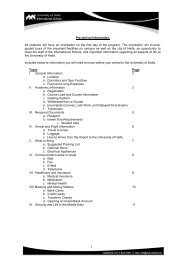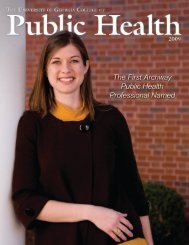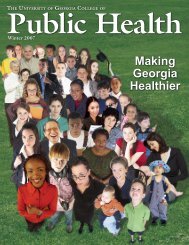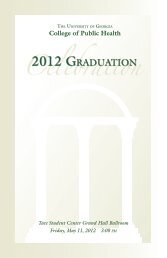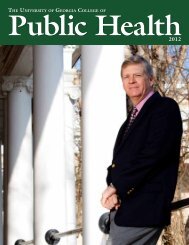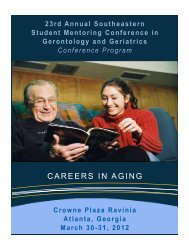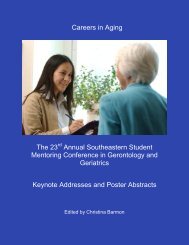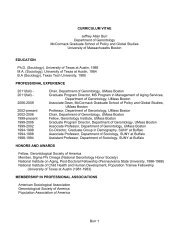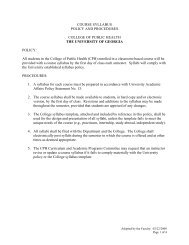Protecting Georgia's Waterways - College of Public Health
Protecting Georgia's Waterways - College of Public Health
Protecting Georgia's Waterways - College of Public Health
Create successful ePaper yourself
Turn your PDF publications into a flip-book with our unique Google optimized e-Paper software.
<strong>Health</strong> Promotion and Behavior<br />
Research Q&A with<br />
Pamela Orpinas<br />
By Helen Fosgate<br />
Pamela Orpinas, pr<strong>of</strong>essor <strong>of</strong> health<br />
promotion and behavior at UGA’s <strong>College</strong><br />
<strong>of</strong> <strong>Public</strong> <strong>Health</strong>, spoke with Helen Fosgate,<br />
the editor <strong>of</strong> ugaresearch, about her<br />
work on bullying and violence in school<br />
settings and her belief that all students deserve<br />
a positive, inviting and safe school environment<br />
in which they are free to learn.<br />
Q: What behaviors qualify as bullying<br />
A: Bullying can range from simple<br />
name-calling to threats and harassment<br />
to more serious things such as stealing<br />
and physical assault that, outside <strong>of</strong><br />
school, are criminal acts. What makes it<br />
bullying is that it is repeated over time,<br />
forming a pattern.<br />
Kids who bully <strong>of</strong>ten have poor social<br />
skills - difficulty with establishing relationships<br />
- and perform badly in school. But<br />
some bullies have especially good social<br />
skills and can influence others to follow<br />
them. Victims have wide-ranging pr<strong>of</strong>iles,<br />
but for the most part they are perceived as<br />
being different in some way. Bullies have<br />
some real or perceived advantage over<br />
their victims, such as more friends, more<br />
money, or the right clothes. We think<br />
about the victims <strong>of</strong> bullying as being less<br />
powerful. They may not have the right<br />
friends or the right clothes, or they may<br />
have a physical or mental disability.<br />
Regardless <strong>of</strong> their disadvantages,<br />
there are basically two types <strong>of</strong> victims:<br />
those who have done nothing at all to invite<br />
the bullying; and those we call “aggressive<br />
victims,” who may irritate or annoy another<br />
student into aggressive behavior and<br />
then claim to have been victimized. Bystanders<br />
also fall into two types. One type<br />
becomes part <strong>of</strong> the problem by laughing<br />
with or otherwise encouraging the bully.<br />
The other type tries to discourage the<br />
bully or even act as witness for teachers<br />
or principals by reporting what they saw.<br />
They become part <strong>of</strong> the solution.<br />
Q: Have bullying and school violence<br />
gotten worse in modern times<br />
A: We don’t really know, as it’s not<br />
a phenomenon that researchers have<br />
quantified over a long period. But we do<br />
know that because violence is so pervasive<br />
in modern society, meanness is <strong>of</strong>ten<br />
considered “cool” and accepted as part<br />
<strong>of</strong> the social norm. Research does show<br />
that boys rate higher both in physical and<br />
relational aggression than do girls. We<br />
expected girls to be lower in physical aggression<br />
but thought they might be higher<br />
in relational aggression. That turns out<br />
not to be the case.<br />
Q: What are some <strong>of</strong> the consequences<br />
A: Sometimes there are the extreme<br />
consequences, such as homicide, which<br />
<strong>of</strong>ten involves a victim who finally takes a<br />
stand; and then there is suicide among victims<br />
who feel powerless to fight back. But<br />
there’s also a wide range <strong>of</strong> effects outside<br />
these extremes, including fear, which may<br />
result in victimized students not eating<br />
lunch or going to the restroom because<br />
<strong>of</strong> concerns about being attacked, physically<br />
or verbally. Their self-esteem and<br />
social lives suffer because other students<br />
don’t want to be seen with them (as they<br />
also could become targets), and victims’<br />
grades can decline. Many bullies report<br />
Pamela Orpinas, pr<strong>of</strong>essor<br />
<strong>of</strong> health promotion and<br />
behavior at the <strong>College</strong> <strong>of</strong><br />
<strong>Public</strong> <strong>Health</strong>, has conducted<br />
research analyzing bullying<br />
and violence in school<br />
settings.<br />
photo by paul efland<br />
that they too feel worse about themselves<br />
than the average student, which may help<br />
to explain the initiation <strong>of</strong> their bullying,<br />
and their own grades and self-esteem suffer,<br />
and sometimes they feel guilty.<br />
Meanwhile, bullying interrupts<br />
teaching and learning, given the students’<br />
emotional and physical problems that<br />
have been created or exacerbated. We<br />
know that both students and teachers perform<br />
best in a positive environment that<br />
promotes trust, mutual caring and respect.<br />
Q: What strategies are most effective at<br />
preventing or reducing school violence<br />
A: Adults <strong>of</strong>ten give the message,<br />
“You should solve this yourself,” but<br />
the victims <strong>of</strong>ten cannot. Most effective<br />
is a positive school environment where<br />
bullying and aggressive behavior is unacceptable,<br />
and teachers have a lot <strong>of</strong><br />
influence in that regard. The limitation<br />
for schools, <strong>of</strong> course, is that they don’t<br />
have any control over what happens at<br />
home or on the street. Victims <strong>of</strong> bullying<br />
should keep a diary so they can report<br />
specific incidences rather than just contend<br />
that “everybody picks on me.” Once<br />
they have some specific complaints, they<br />
can go to a trusted teacher, principal or<br />
school counselor and develop a plan to<br />
stop the bullying. And no one plan fits all<br />
students or situations. In any case, teachers<br />
and administrators must establish<br />
rules for the school, despite what may be<br />
acceptable at home.<br />
(This piece was originally published<br />
in ugaresearch magazine, University <strong>of</strong><br />
Georgia.)<br />
Croatia Study Abroad Program Turns Five<br />
By Johnathan McGinty<br />
Celebrating its fifth anniversary<br />
this year, the Croatia Maymester Study<br />
Abroad program recently took 26 students<br />
to culturally rich Croatia to explore<br />
its cultural history and continuing<br />
societal challenges.<br />
The program, which is generously<br />
supported by a gift from Dr. and Mrs.<br />
Lawrence Phillips, spans four colleges<br />
at UGA and covers multiple disciplines<br />
from seemingly unconnected academic<br />
disciplines. Using Zagreb, Motovun<br />
and Makarska as their central bases this<br />
year, the students are exposed to public<br />
health, Croatian culture and language,<br />
historic preservation principles and political<br />
conflict studies.<br />
It is the only program <strong>of</strong>fered at UGA<br />
that incorporates curriculum from four<br />
different colleges – the <strong>College</strong> <strong>of</strong> <strong>Public</strong><br />
<strong>Health</strong>, the School <strong>of</strong> Environment and<br />
Design, Germanic and Slavic Studies and<br />
the School <strong>of</strong> <strong>Public</strong> and International Affairs<br />
– into one study program.<br />
Carol Cotton, an academic pr<strong>of</strong>essional<br />
in <strong>Health</strong> Promotion and Behavior<br />
at the <strong>College</strong> <strong>of</strong> <strong>Public</strong> <strong>Health</strong>,<br />
said the program’s diversity is one <strong>of</strong> its<br />
greatest strengths.<br />
“One <strong>of</strong> the most valuable things<br />
about the program is how we integrate<br />
it all,” Cotton said. “We don’t separate<br />
it, so it’s not just a public health course.<br />
It’s made so much richer by having four<br />
completely different colleges involved.”<br />
The participating students, despite<br />
their diverse academic backgrounds, remain<br />
together as a group for the majority<br />
<strong>of</strong> the program. As a result, they are<br />
exposed to areas <strong>of</strong> study they traditionally<br />
would not experience.<br />
Cotton said the mutual learning is<br />
intentional, and not simply because it<br />
enables the group to bond during their<br />
time overseas. Despite the differences<br />
in the disciplines, the traveling faculty<br />
work to link the relationships between<br />
the four areas <strong>of</strong> study.<br />
“We overlay all <strong>of</strong> these components<br />
so they know that you can’t have one <strong>of</strong><br />
these issues without another,” Cotton<br />
said. “For example, you can’t have a military<br />
if you don’t have a healthy population.<br />
And, when you have a military, you<br />
have a number <strong>of</strong> resources that are redirected<br />
to take care <strong>of</strong> it, and we look at<br />
how that reallocation impacts the overall<br />
population.”<br />
Additionally, Croatia proves to be a<br />
unique learning laboratory for students.<br />
The nation is undergoing two massive<br />
societal and political changes that<br />
are not simply redefining it, but also<br />
providing an important educational opportunity<br />
for the students participating<br />
in the program.<br />
First, the country is preparing to<br />
join the European Union, so there is<br />
ample work being done in advance <strong>of</strong><br />
that key move. Second, and perhaps<br />
more challenging, is Croatia’s transition<br />
from being a socialist state to a capitalist<br />
state. Under the old regime, health<br />
care was provided to all citizens and paid<br />
through taxation.<br />
“Now, they’re transitioning to this<br />
new, capitalist system where it’s something<br />
they have to pay for, and that’s<br />
new to them,” Cotton said. “They have<br />
to deal with insurance, they have to deal<br />
with the health <strong>of</strong> refugee populations<br />
and they have to deal with the health <strong>of</strong><br />
minority populations.”<br />
The myriad <strong>of</strong> challenges facing<br />
Croatia creates a tremendous learning<br />
opportunity for the students.<br />
“This is an experiential trip,” Cotton<br />
said. “We do not take our classrooms<br />
that we teach with at UGA and<br />
just plunk them down in Croatia. We<br />
don’t believe in that, but we do believe<br />
in experiential learning.”<br />
Four faculty members and 30 students<br />
participated in the 2010 Croatia Study<br />
Abroad program. In this photo, the<br />
students pose at the ruins <strong>of</strong> a town<br />
in Dvigrad, Istria, Croatia that was<br />
abandoned due to the plague.<br />
12 <strong>College</strong> <strong>of</strong> <strong>Public</strong> <strong>Health</strong> Fall 2010 13




